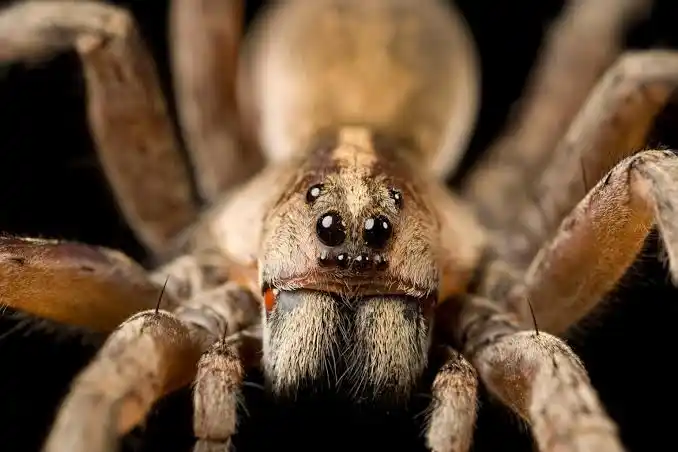SPIDER BLOOD
Spiders have transparent blood.
The spiders have circulating blood in their bodies. The colorless blood, called hemolymph, transports nutrients, hormones, oxygen, and cells. The blood also serves another purpose. It is used locally to raise blood pressure during molting (shedding old skin) and stretch the legs.
In mammals, hemoglobin molecules present in the red blood cells transport oxygen. The spider uses a more complicated protein called hemocyanin. Unlike hemoglobin, hemocyanin is not stored in a cell but flows freely in the blood of a spider. Hemocyanin is a protein comprised of 24 subunits with a molecular mass of 1.704.000 compared to the molecular mass of oxygen, which is only 32.
Human hemoglobin comprises four subunits with a molecular mass of 64.500. Hemoglobin is a molecular disc made of nitrogen, carbon, hydrogen, and an iron atom at the center. The oxidized iron gives the molecule its characteristic red color. Haemocyanin also contains nitrogen, carbon, and hydrogen but has a copper atom at the center instead of an iron atom. The oxidized copper gives the molecule a blue color. Hemocyanin binds oxygen but only releases it after it receives the right chemical signal.
For each of the 24 sub-units, there is a special chemical signal. A cell can give more or fewer signals depending on the need for oxygen. Besides these signals, the release of oxygen is also controlled by temperature. Every sub-unit has a specific temperature optimum.
Source: The Ultimate Facts App
Photo Source: National Geographic
Spiders have transparent blood.
The spiders have circulating blood in their bodies. The colorless blood, called hemolymph, transports nutrients, hormones, oxygen, and cells. The blood also serves another purpose. It is used locally to raise blood pressure during molting (shedding old skin) and stretch the legs.
In mammals, hemoglobin molecules present in the red blood cells transport oxygen. The spider uses a more complicated protein called hemocyanin. Unlike hemoglobin, hemocyanin is not stored in a cell but flows freely in the blood of a spider. Hemocyanin is a protein comprised of 24 subunits with a molecular mass of 1.704.000 compared to the molecular mass of oxygen, which is only 32.
Human hemoglobin comprises four subunits with a molecular mass of 64.500. Hemoglobin is a molecular disc made of nitrogen, carbon, hydrogen, and an iron atom at the center. The oxidized iron gives the molecule its characteristic red color. Haemocyanin also contains nitrogen, carbon, and hydrogen but has a copper atom at the center instead of an iron atom. The oxidized copper gives the molecule a blue color. Hemocyanin binds oxygen but only releases it after it receives the right chemical signal.
For each of the 24 sub-units, there is a special chemical signal. A cell can give more or fewer signals depending on the need for oxygen. Besides these signals, the release of oxygen is also controlled by temperature. Every sub-unit has a specific temperature optimum.
Source: The Ultimate Facts App
Photo Source: National Geographic
SPIDER BLOOD
Spiders have transparent blood.
The spiders have circulating blood in their bodies. The colorless blood, called hemolymph, transports nutrients, hormones, oxygen, and cells. The blood also serves another purpose. It is used locally to raise blood pressure during molting (shedding old skin) and stretch the legs.
In mammals, hemoglobin molecules present in the red blood cells transport oxygen. The spider uses a more complicated protein called hemocyanin. Unlike hemoglobin, hemocyanin is not stored in a cell but flows freely in the blood of a spider. Hemocyanin is a protein comprised of 24 subunits with a molecular mass of 1.704.000 compared to the molecular mass of oxygen, which is only 32.
Human hemoglobin comprises four subunits with a molecular mass of 64.500. Hemoglobin is a molecular disc made of nitrogen, carbon, hydrogen, and an iron atom at the center. The oxidized iron gives the molecule its characteristic red color. Haemocyanin also contains nitrogen, carbon, and hydrogen but has a copper atom at the center instead of an iron atom. The oxidized copper gives the molecule a blue color. Hemocyanin binds oxygen but only releases it after it receives the right chemical signal.
For each of the 24 sub-units, there is a special chemical signal. A cell can give more or fewer signals depending on the need for oxygen. Besides these signals, the release of oxygen is also controlled by temperature. Every sub-unit has a specific temperature optimum.
Source: The Ultimate Facts App
Photo Source: National Geographic





